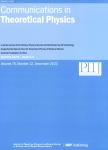A Lattice Model for Bidirectional Pedestrian Flow on Gradient Road
A Lattice Model for Bidirectional Pedestrian Flow on Gradient Road作者机构:Faculty of Maritime and Transportation Ningbo University National Traffic Management Engineering & Technology Research Centre Ningbo University Sub-centre Jiangsu Province Collaborative Innovation Center Modern Urban Traffic Technologies Department of Fundamental CourseNingbo Institute of TechnologyZhejiang University Department of Civil and Architectural EngineeringCity University of Hong KongTat Chee AvenueKowloonHongKong China
出 版 物:《Communications in Theoretical Physics》 (理论物理通讯(英文版))
年 卷 期:2014年第61卷第8期
页 面:259-264页
核心收录:
学科分类:08[工学] 082302[工学-交通信息工程及控制] 0823[工学-交通运输工程] 0702[理学-物理学]
基 金:Supported by the National Natural Science Foundation of China under Grant Nos.11372166,11262005,11262003 the Scientific Research Fund of Zhejiang Provincial under Grant No.LQ13D050002 the K.C.Wong Magna Fund in Ningbo University,China,Government of the Hong Kong Administrative Region,China No.119011
主 题:pedestrian flow lattice hydrodynamic model gradient road
摘 要:Ramps and sloping roads appear everywhere in the built environment. It is obvious that the movement pattern of people in the sloping path may be different as compared with the pattern on level roads. Previously, most of the studies, especially the mathematical and simulation models, on pedestrian movement consider the flow at level routes.This study proposes a new lattice model for bidirectional pedestrian flow on gradient road. The stability condition is obtained by using linear stability theory. The nonlinear analysis method is employed to derive the modified Korteweg-de Vries(mKdV) equation, and the space of pedestrian flow is divided into three regions: the stable region, the metastable region, and the unstable region respectively. Furthermore, the time-dependent Ginzburg–Landan(TDGL) equation is deduced and solved through the reductive perturbation method. Finally, we present detailed results obtained from the model, and it is found that the stability of the model is enhanced in uphill situation while reduced in downhill situation with increasing slope.



